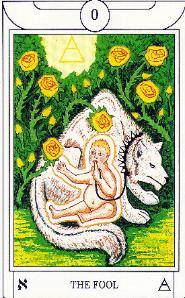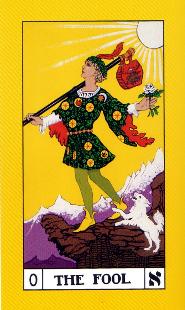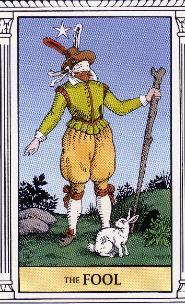Alchemy, Psychotherapy, Tarot
Too few people have experienced the divine image as the innermost possession of their own souls
Carl G. Jung
The Great Work is the operation of the Sun and the Moon by the aid of Mercury
Hermetic Philosophy
The importance of alchemy in the development of chemistry hardly needs discussion, but the psychological, sociocultural and religious implications of alchemy continue to provide fertile ground for argument. From a historical perspective, alchemy served to blend and incorporate old magical beliefs, myths and prehistorical traditions related to man’s quest to perfect and transcend matter. The alchemist, like his predecessors the smith and the potter or like the magicians and shamans of ancient civilizations, was first and foremost a master of fire. The alchemist represents the demiurge, the divine craftsman who works with an elusive and often chaotic prima materia, attempting to transcend time while rendering matter a spiritual dimension and looking for ways to reach personal perfection and immortality (see Mircea Eliade, The Forge and the Crucible). In the alchemist’s work ores, minerals and other substances are regarded as living organisms capable of reflecting, when subjected to various processes and amalgamations, the literal, symbolic and mythic aspects of our own Self.
Carl Jung stumbled upon alchemical symbolism and its operations and made the magical connection between alchemy and the psychological maturation processes he named individuation. Jung thus applied old chemical formulas and pseudo chemical language to psychological processes that reflect his own interpretation of our personal journeys into wholeness. The alchemical opus became the process of individuation and the lapis philosophorum and elixir vitae the ultimate goals of the complete and whole human being finally united with the Godhead. So, the ideas connected to the elixir of life or the Philosopher's Stone refer to the ability to reach the highest possible state of consciousness available to each of us.
Jung maintained that the mystery of creation (mysterium magnum) is first and foremost rooted in the human psyche. In Jung’s postulation about the structure of the psyche the ego is the dominant complex that rules our life. Jung placed the ego above the personal "unconscious," the third level of the psyche where we each personalize the universal archetypal symbols and experiences emanating from the collective unconscious. If we assume that everything stems from unity and oneness and that birth is a form of separation or “fall,” it is the ego energy that rushes to define us within the basic dualities, the world of opposites and apparent separateness that rule our existence.
How we individualize the archetypes emanating from the collective unconscious determines our subjective sense of self. Most of us adapt to our milieu by adopting a persona that serves to represent us to the outside world; but this exterior is just an aspect of our ego consciousness and does not reflect who we really are. Most of the alchemical operations are intended to work (at least at first) on this persona.
In the Hermetic traditions, when the alchemist was called to the task of transforming lead into gold, we should interpret this process beyond the literal into the symbolic, as a process aimed at extracting the soul out of matter -the "spiritization" of matter - and where transformation of the various ingredients and substances in the lab was being also eflected in the alchemist himself. Jung’s work with the psyche found an uncanny resonance with the alchemist's work in the lab. It was magical. For Jung the soul was hidden deep within the unconscious structures of our mind and was the complex that carried the God archetype. In the western world most people are satisfied with externals and they feel safer transferring their notion of wholeness to idealized images (i.e. Christ or the Virgin Mary, a cross, the Tree of Life, mandalas, or any other symbol that carries magical or talismanic dimensions for us). A more tangible -maybe even more accessible- image becomes almost impossible to fathom or to accept because our real sense of redemption is usually connected to something outside of our Self.
When we are able to connect with the energies within that give us access to our divinity we stop projecting our salvation, redemption to objects outside of ourselves. This is how we start realizing that we each forge our own destiny and that we are, indeed, in charge of the choices that define our lives. I would argue here that Tarot can serve as a tool to help us connect with not only the invisible world of our guides and teachers, with the world of elementals, with the dream and astral dimensions, but also that Tarot is an excellent alchemical tool. The seventy-eight cards provide us with vessels in which to perform the various operations, they reflect the Zodiac, they are magical tools, they project a limitless number of states of consciousnesses, they are a fountain of ancient knowledge and provide a cosmology that continually accrues more and more wisdom and potentialities of interpretation.
Carl Jung worked extensively with the I Ching -the old divination texts from ancient, shamanic China- as an effective tool in psychotherapy. (See, for example, “The Tao and the Classic of Change” (C.W.) or his "Foreword" to the Wilhelm, Baynes The I Ching.) Tarot can be just as effective as the I Ching, when used as a tool to help us establish a special relationship with the unconscious, to help us identify the archetypes that rule our every day life; to help us understand better our actions and reactions within a given context or quandary. Through divination we can access synchronicity, the magical merge of time and space where we find meaningful coincidence and uncanny resonance. As we consult the cards, we can become the prima materia, the object of inquiry as well as the vessel where the transformation occurs - the athanor or alchemical oven. The work we do is the Opus; the Philosopher's Stone becomes the goal of our transformation. We are both the agent and the object of the transformation; the observer and the observed; the actor and that which is acted upon.
Alchemy of soul is all about knowing ourselves, through self inquiry and humility. It is also about seeking the truth about ourselves, and who we really are.


Prima materia
I love this image of an infant found in some Tarot decks as Key 0 The Fool, which is similar to the idea we find in some alchemical texts symbolizing the essence of the prima materia, the undifferentiated state that presents to us the matter in need of transformation.
In this version of the Fool from the Golden Dawn Magical Tarot we see the image of the archetypal Harpocrates, the Greek god of silence, usually depicted as a baby with his finger to his lips; he is also the Egyptian god Horus, son of Isis and Osiris to whom the mysteries of creation would be revealed. In the BOTA version, below left, we find the archetypal eye of Horus on the Fool’s bag and the white sun of the east, another symbol associated with Horus. In both cases we can extract the meaning of the child archetype in state of grace: a magical child embarking on a life journey. The new sun intimates full potential for both body and soul to be able to reach a new level of awareness. Robert M. Place's Alchemical Tarot version of The Fool below shows us the alchemist ready to embark on his work or opus, blindfold and unawares that he is about to start his own initiation by going through the rabbit hole of the subconscious. This image is taken from The Mountain Cave of the Adepts in Michelspacher's Cabala, 1654, which is a symbolical drawing of the alchemist's journey. Whatever the image, the message is pretty much the same. Because, at every learning juncture in our lives, we must become the prima materia as well as the alchemist and the agency at work for the transformation to occur. Notice how in each version of Key 0 the yellow roses, or the white sun, or the eye of Horus or the star behind the blindfold alchemist, all these symbols serve to remind us that we are always guided by the Divine Light.
Of all the substances used by the alchemist, mercury was the most critical and elusive (in symbology and meaning). Jung talks about the Spirit Mercurius as the autonomous spirit of the archetypal psyche. Subjecting mercurius to different processes (bringing this autonomous complex into consciousness) yielded different transformations. In a way, mercurius is the alchemical ourobouros, the snake biting its own tail that is transformed as it transforms us. This is the spiral of creation that ultimately captures the essence of alchemy. Like anything dealing with spirit, alchemy defies verbal limitations.
Alchemical processes of transformation and the psychic operations leading to them are taking place all the time in our lives. We all experience psychological stages that demand that we let go, burn, dissolve, regroup, restructure our thoughts and dispositions. Most of the time, our ego refuses to undergo any change and the outcome of these operations depends to a great extent on our ego’s strength or resiliency.

Eventually, after many times of stumbling and falling and asking why, it finally dawns on us that some deep work is needed. We meditate, analyze and dig deep in our minds like psychological miners going from darkness into the light until we consciously start to be aware of the forces and energies that lead us to transformation. If we fully and consciously engage in the process, our road to individuation becomes easier and more accessible.
The rewards at the end of the journey are more than worth it.
The Fool images are from The Golden Dawn Magical Tarot, Builders of the Adytum and The Alchemical Tarot.
Yolanda M. Robinson, Ph.D.